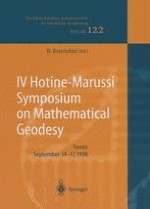2001 | OriginalPaper | Buchkapitel
Softly Unbiased Prediction Part 2: The Random Effects Model
verfasst von : Burkhard Schaffrin
Erschienen in: IV Hotine-Marussi Symposium on Mathematical Geodesy
Verlag: Springer Berlin Heidelberg
Enthalten in: Professional Book Archive
Aktivieren Sie unsere intelligente Suche, um passende Fachinhalte oder Patente zu finden.
Wählen Sie Textabschnitte aus um mit Künstlicher Intelligenz passenden Patente zu finden. powered by
Markieren Sie Textabschnitte, um KI-gestützt weitere passende Inhalte zu finden. powered by
At the First Hotine-Marussi Symposion, this author compared varieous methods to pretict the sate vector” within a Random Effects Model ineluding inhomBLIP (”lesst-squar” collocation”), homI3LIP and horn- BLUP (”robust collocation”); see (1986). The term ”robust” refers to the specific restance of homBLUP against scale errore In the prior infonnation. The case of resistance against multiple scale errors was later discussed in tvo popers by 8. Sehaf-frin/B, Middd tl989; 1991) related to terrestrial gravity field studies.In the meantime, the question was asked whether there ia a continuous transition between homBLUP (which is weakly unbiased) and homBLIP (which is ”more efficient” than homBLUP). Such an intermediate predictor would allow us to give up some rigor in the un-biasednes condition in order to gain more ”efficiency”, i. e., a smaller Mean-Square-Error matrix. First results have been presented for univariate spatial processes in the context of Ordinary Kriging by (1997).In the following we shall introduce the notion of ”Softly Unbiased Prediction” and present the corresponding formulas for the homBLISUP (Best homogeneously Linear Softly Unbiased Predictor) within a Random Effects Model.A similar approach within the GaussMarkov Model led to the BLUSUE (Best Linear Uniformly Softly Unbiased Eatimator) of the parameters; see (1998).
